对音频切分成小音频(机器学习用)
我是把so-vits中小工具,分析源码然后提取出来了。以后可以写在自己的程序里。
-------流程(这是我做的流程,你可以不用看)
从开源代码中快速获取自己需要的东西
如果有界面f12看他里面的接口,然后在源码中全局搜索,没有接口比如socket,看他的消息字段,然后推测。然后提取补齐代码就行了
-------
你需要看的
提取出来有3个类

run.py是我自己写的
其他是我提取的源码,首先你得install一些包
numpy,librosa,soundfile
slicer2.py
import numpy as np# This function is obtained from librosa.
def get_rms(y,*,frame_length=2048,hop_length=512,pad_mode="constant",
):padding = (int(frame_length // 2), int(frame_length // 2))y = np.pad(y, padding, mode=pad_mode)axis = -1# put our new within-frame axis at the end for nowout_strides = y.strides + tuple([y.strides[axis]])# Reduce the shape on the framing axisx_shape_trimmed = list(y.shape)x_shape_trimmed[axis] -= frame_length - 1out_shape = tuple(x_shape_trimmed) + tuple([frame_length])xw = np.lib.stride_tricks.as_strided(y, shape=out_shape, strides=out_strides)if axis < 0:target_axis = axis - 1else:target_axis = axis + 1xw = np.moveaxis(xw, -1, target_axis)# Downsample along the target axisslices = [slice(None)] * xw.ndimslices[axis] = slice(0, None, hop_length)x = xw[tuple(slices)]# Calculate powerpower = np.mean(np.abs(x) ** 2, axis=-2, keepdims=True)return np.sqrt(power)class Slicer:def __init__(self,sr: int,threshold: float = -40.,min_length: int = 5000,min_interval: int = 300,hop_size: int = 20,max_sil_kept: int = 5000):if not min_length >= min_interval >= hop_size:raise ValueError('The following condition must be satisfied: min_length >= min_interval >= hop_size')if not max_sil_kept >= hop_size:raise ValueError('The following condition must be satisfied: max_sil_kept >= hop_size')min_interval = sr * min_interval / 1000self.threshold = 10 ** (threshold / 20.)self.hop_size = round(sr * hop_size / 1000)self.win_size = min(round(min_interval), 4 * self.hop_size)self.min_length = round(sr * min_length / 1000 / self.hop_size)self.min_interval = round(min_interval / self.hop_size)self.max_sil_kept = round(sr * max_sil_kept / 1000 / self.hop_size)def _apply_slice(self, waveform, begin, end):if len(waveform.shape) > 1:return waveform[:, begin * self.hop_size: min(waveform.shape[1], end * self.hop_size)]else:return waveform[begin * self.hop_size: min(waveform.shape[0], end * self.hop_size)]# @timeitdef slice(self, waveform):if len(waveform.shape) > 1:samples = waveform.mean(axis=0)else:samples = waveformif samples.shape[0] <= self.min_length:return [waveform]rms_list = get_rms(y=samples, frame_length=self.win_size, hop_length=self.hop_size).squeeze(0)sil_tags = []silence_start = Noneclip_start = 0for i, rms in enumerate(rms_list):# Keep looping while frame is silent.if rms < self.threshold:# Record start of silent frames.if silence_start is None:silence_start = icontinue# Keep looping while frame is not silent and silence start has not been recorded.if silence_start is None:continue# Clear recorded silence start if interval is not enough or clip is too shortis_leading_silence = silence_start == 0 and i > self.max_sil_keptneed_slice_middle = i - silence_start >= self.min_interval and i - clip_start >= self.min_lengthif not is_leading_silence and not need_slice_middle:silence_start = Nonecontinue# Need slicing. Record the range of silent frames to be removed.if i - silence_start <= self.max_sil_kept:pos = rms_list[silence_start: i + 1].argmin() + silence_startif silence_start == 0:sil_tags.append((0, pos))else:sil_tags.append((pos, pos))clip_start = poselif i - silence_start <= self.max_sil_kept * 2:pos = rms_list[i - self.max_sil_kept: silence_start + self.max_sil_kept + 1].argmin()pos += i - self.max_sil_keptpos_l = rms_list[silence_start: silence_start + self.max_sil_kept + 1].argmin() + silence_startpos_r = rms_list[i - self.max_sil_kept: i + 1].argmin() + i - self.max_sil_keptif silence_start == 0:sil_tags.append((0, pos_r))clip_start = pos_relse:sil_tags.append((min(pos_l, pos), max(pos_r, pos)))clip_start = max(pos_r, pos)else:pos_l = rms_list[silence_start: silence_start + self.max_sil_kept + 1].argmin() + silence_startpos_r = rms_list[i - self.max_sil_kept: i + 1].argmin() + i - self.max_sil_keptif silence_start == 0:sil_tags.append((0, pos_r))else:sil_tags.append((pos_l, pos_r))clip_start = pos_rsilence_start = None# Deal with trailing silence.total_frames = rms_list.shape[0]if silence_start is not None and total_frames - silence_start >= self.min_interval:silence_end = min(total_frames, silence_start + self.max_sil_kept)pos = rms_list[silence_start: silence_end + 1].argmin() + silence_startsil_tags.append((pos, total_frames + 1))# Apply and return slices.if len(sil_tags) == 0:return [waveform]else:chunks = []if sil_tags[0][0] > 0:chunks.append(self._apply_slice(waveform, 0, sil_tags[0][0]))for i in range(len(sil_tags) - 1):chunks.append(self._apply_slice(waveform, sil_tags[i][1], sil_tags[i + 1][0]))if sil_tags[-1][1] < total_frames:chunks.append(self._apply_slice(waveform, sil_tags[-1][1], total_frames))return chunksdef main():import os.pathfrom argparse import ArgumentParserimport librosaimport soundfileparser = ArgumentParser()parser.add_argument('audio', type=str, help='The audio to be sliced')parser.add_argument('--out', type=str, help='Output directory of the sliced audio clips')parser.add_argument('--db_thresh', type=float, required=False, default=-40,help='The dB threshold for silence detection')parser.add_argument('--min_length', type=int, required=False, default=5000,help='The minimum milliseconds required for each sliced audio clip')parser.add_argument('--min_interval', type=int, required=False, default=300,help='The minimum milliseconds for a silence part to be sliced')parser.add_argument('--hop_size', type=int, required=False, default=10,help='Frame length in milliseconds')parser.add_argument('--max_sil_kept', type=int, required=False, default=500,help='The maximum silence length kept around the sliced clip, presented in milliseconds')args = parser.parse_args()out = args.outif out is None:out = os.path.dirname(os.path.abspath(args.audio))audio, sr = librosa.load(args.audio, sr=None, mono=False)slicer = Slicer(sr=sr,threshold=args.db_thresh,min_length=args.min_length,min_interval=args.min_interval,hop_size=args.hop_size,max_sil_kept=args.max_sil_kept)chunks = slicer.slice(audio)if not os.path.exists(out):os.makedirs(out)for i, chunk in enumerate(chunks):if len(chunk.shape) > 1:chunk = chunk.Tsoundfile.write(os.path.join(out, f'%s_%d.wav' % (os.path.basename(args.audio).rsplit('.', maxsplit=1)[0], i)), chunk, sr)if __name__ == '__main__':main()
auto_slicer.py
import os
import numpy as np
import librosa
import soundfile as sf
from slicer2 import Slicerclass AutoSlicer:def __init__(self):self.slicer_params = {"threshold": -40,"min_length": 5000,"min_interval": 300,"hop_size": 10,"max_sil_kept": 500,}self.original_min_interval = self.slicer_params["min_interval"]def auto_slice(self, filename, input_dir, output_dir, max_sec):audio, sr = librosa.load(os.path.join(input_dir, filename), sr=None, mono=False)slicer = Slicer(sr=sr, **self.slicer_params)chunks = slicer.slice(audio)files_to_delete = []for i, chunk in enumerate(chunks):if len(chunk.shape) > 1:chunk = chunk.Toutput_filename = f"{os.path.splitext(filename)[0]}_{i}"output_filename = "".join(c for c in output_filename if c.isascii() or c == "_") + ".wav"output_filepath = os.path.join(output_dir, output_filename)sf.write(output_filepath, chunk, sr)#Check and re-slice audio that more than max_sec.while True:new_audio, sr = librosa.load(output_filepath, sr=None, mono=False)if librosa.get_duration(y=new_audio, sr=sr) <= max_sec:breakself.slicer_params["min_interval"] = self.slicer_params["min_interval"] // 2if self.slicer_params["min_interval"] >= self.slicer_params["hop_size"]:new_chunks = Slicer(sr=sr, **self.slicer_params).slice(new_audio)for j, new_chunk in enumerate(new_chunks):if len(new_chunk.shape) > 1:new_chunk = new_chunk.Tnew_output_filename = f"{os.path.splitext(output_filename)[0]}_{j}.wav"sf.write(os.path.join(output_dir, new_output_filename), new_chunk, sr)files_to_delete.append(output_filepath)else:breakself.slicer_params["min_interval"] = self.original_min_intervalfor file_path in files_to_delete:if os.path.exists(file_path):os.remove(file_path)def merge_short(self, output_dir, max_sec, min_sec):short_files = []for filename in os.listdir(output_dir):filepath = os.path.join(output_dir, filename)if filename.endswith(".wav"):audio, sr = librosa.load(filepath, sr=None, mono=False)duration = librosa.get_duration(y=audio, sr=sr)if duration < min_sec:short_files.append((filepath, audio, duration))short_files.sort(key=lambda x: x[2], reverse=True)merged_audio = []current_duration = 0for filepath, audio, duration in short_files:if current_duration + duration <= max_sec:merged_audio.append(audio)current_duration += durationos.remove(filepath)else:if merged_audio:output_audio = np.concatenate(merged_audio, axis=-1)if len(output_audio.shape) > 1:output_audio = output_audio.Toutput_filename = f"merged_{len(os.listdir(output_dir))}.wav"sf.write(os.path.join(output_dir, output_filename), output_audio, sr)merged_audio = [audio]current_duration = durationos.remove(filepath)if merged_audio and current_duration >= min_sec:output_audio = np.concatenate(merged_audio, axis=-1)if len(output_audio.shape) > 1:output_audio = output_audio.Toutput_filename = f"merged_{len(os.listdir(output_dir))}.wav"sf.write(os.path.join(output_dir, output_filename), output_audio, sr)def slice_count(self, input_dir, output_dir):orig_duration = final_duration = 0for file in os.listdir(input_dir):if file.endswith(".wav"):_audio, _sr = librosa.load(os.path.join(input_dir, file), sr=None, mono=False)orig_duration += librosa.get_duration(y=_audio, sr=_sr)wav_files = [file for file in os.listdir(output_dir) if file.endswith(".wav")]num_files = len(wav_files)max_duration = -1min_duration = float("inf")for file in wav_files:file_path = os.path.join(output_dir, file)audio, sr = librosa.load(file_path, sr=None, mono=False)duration = librosa.get_duration(y=audio, sr=sr)final_duration += float(duration)if duration > max_duration:max_duration = float(duration)if duration < min_duration:min_duration = float(duration)return num_files, max_duration, min_duration, orig_duration, final_durationrun.py
import os
from auto_slicer import AutoSlicer
import librosa
def slicer_fn(input_dir, output_dir, process_method, max_sec, min_sec):if output_dir == "":return "请先选择输出的文件夹"if output_dir == input_dir:return "输出目录不能和输入目录相同"slicer = AutoSlicer()if os.path.exists(output_dir) is not True:os.makedirs(output_dir)for filename in os.listdir(input_dir):if filename.lower().endswith(".wav"):slicer.auto_slice(filename, input_dir, output_dir, max_sec)if process_method == "丢弃":for filename in os.listdir(output_dir):if filename.endswith(".wav"):filepath = os.path.join(output_dir, filename)audio, sr = librosa.load(filepath, sr=None, mono=False)if librosa.get_duration(y=audio, sr=sr) < min_sec:os.remove(filepath)elif process_method == "将过短音频整合为长音频":slicer.merge_short(output_dir, max_sec, min_sec)file_count, max_duration, min_duration, orig_duration, final_duration = slicer.slice_count(input_dir, output_dir)hrs = int(final_duration / 3600)mins = int((final_duration % 3600) / 60)sec = format(float(final_duration % 60), '.2f')rate = format(100 * (final_duration / orig_duration), '.2f') if orig_duration != 0 else 0rate_msg = f"为原始音频时长的{rate}%" if rate != 0 else "因未知问题,无法计算切片时长的占比"return f"成功将音频切分为{file_count}条片段,其中最长{max_duration}秒,最短{min_duration}秒,切片后的音频总时长{hrs:02d}小时{mins:02d}分{sec}秒,{rate_msg}"input_dir="F:\sliper\input"#输入文件夹(这里面可以放多个wav)
output_dir="F:\sliper\output"#输出文件夹
process_method="丢弃"#如果音频小于3就丢弃
max_sec=15#音频最长为15
min_sec=3#音频最小为3
slicer_fn(input_dir,output_dir,process_method,max_sec,min_sec)测试输入

得到
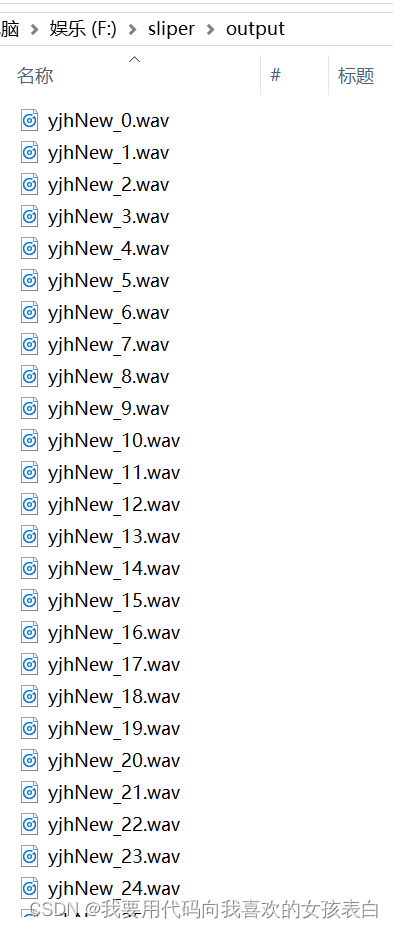
相关文章:

对音频切分成小音频(机器学习用)
我是把so-vits中小工具,分析源码然后提取出来了。以后可以写在自己的程序里。 -------流程(这是我做的流程,你可以不用看) 从开源代码中快速获取自己需要的东西 如果有界面f12看他里面的接口,然后在源码中全局搜索&…...

TensorFlow案例学习:对服装图像进行分类
前言 官方为我们提供了一个 对服装图像进行分类 的案例,方便我们快速学习 学习 预处理数据 案例中有下面这段代码 # 预处理数据,检查训练集中的第一个图像可以看到像素值处于0~255之间 plt.figure() # 创建图像窗口 plt.imshow(train_images[0]) # …...

单目3D目标检测——SMOKE 模型推理 | 可视化结果
本文分享SMOKE的模型推理,和可视化结果。以kitti数据集为例子,对训练完的模型进行推理,并可视化3D框的结果,画到图像中。 关于模型原理、搭建开发环境、模型训练,可以参考之前的博客: 【论文解读】SMOKE …...

C++智能指针shared_ptr使用详解
shared_ptr 是一个共享所有权的智能指针,允许多个指针指向同一个对象。 shared_ptr使用引用计数,每一个shared_ptr的拷贝都指向相同的内存。每使用它一次,内部的引用计数加1,每析构一次,内部的引用计数减1,减为0时,释放所指向的堆内存。shared_ptr内部的引用计数是…...
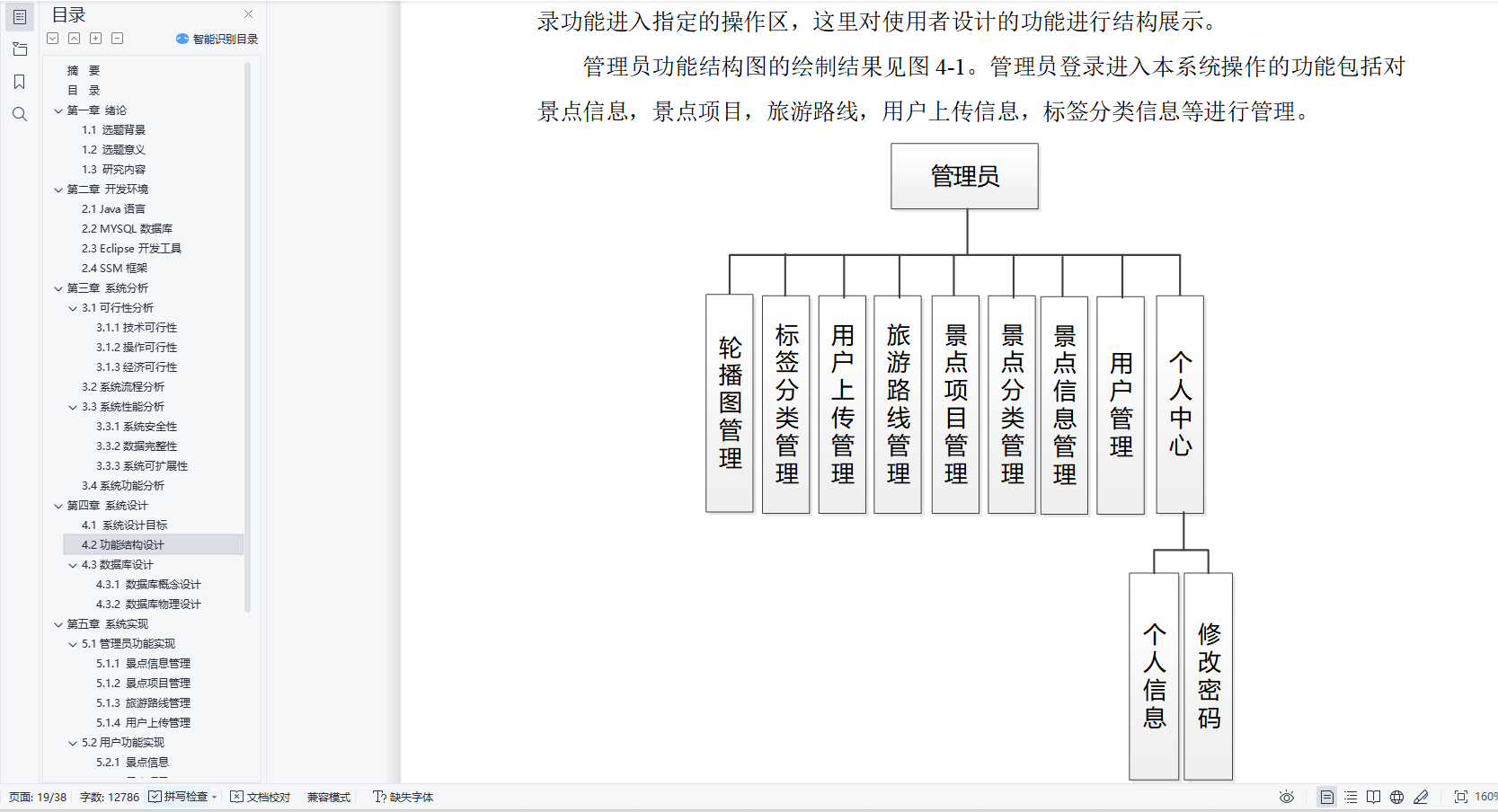
基于Java的个性化旅游攻略系统设计与实现(源码+lw+ppt+部署文档+视频讲解等)
文章目录 前言具体实现截图论文参考详细视频演示代码参考源码获取 前言 💗博主介绍:✌全网粉丝10W,CSDN特邀作者、博客专家、CSDN新星计划导师、全栈领域优质创作者,博客之星、掘金/华为云/阿里云/InfoQ等平台优质作者、专注于Java、小程序技…...

中国替代方案探索:替代谷歌企业邮箱的选择
“谷歌企业邮箱在中国有哪些替代方案?在中国市场上表现出色的企业邮箱有腾讯企业邮箱、网易企业邮箱、阿里企业邮箱以及适合外贸的Zoho Mail企业邮箱。” 在中国由于各种原因,包括网络安全、数据隐私保护以及与GFW(防火长城)等,谷歌企业邮箱并…...
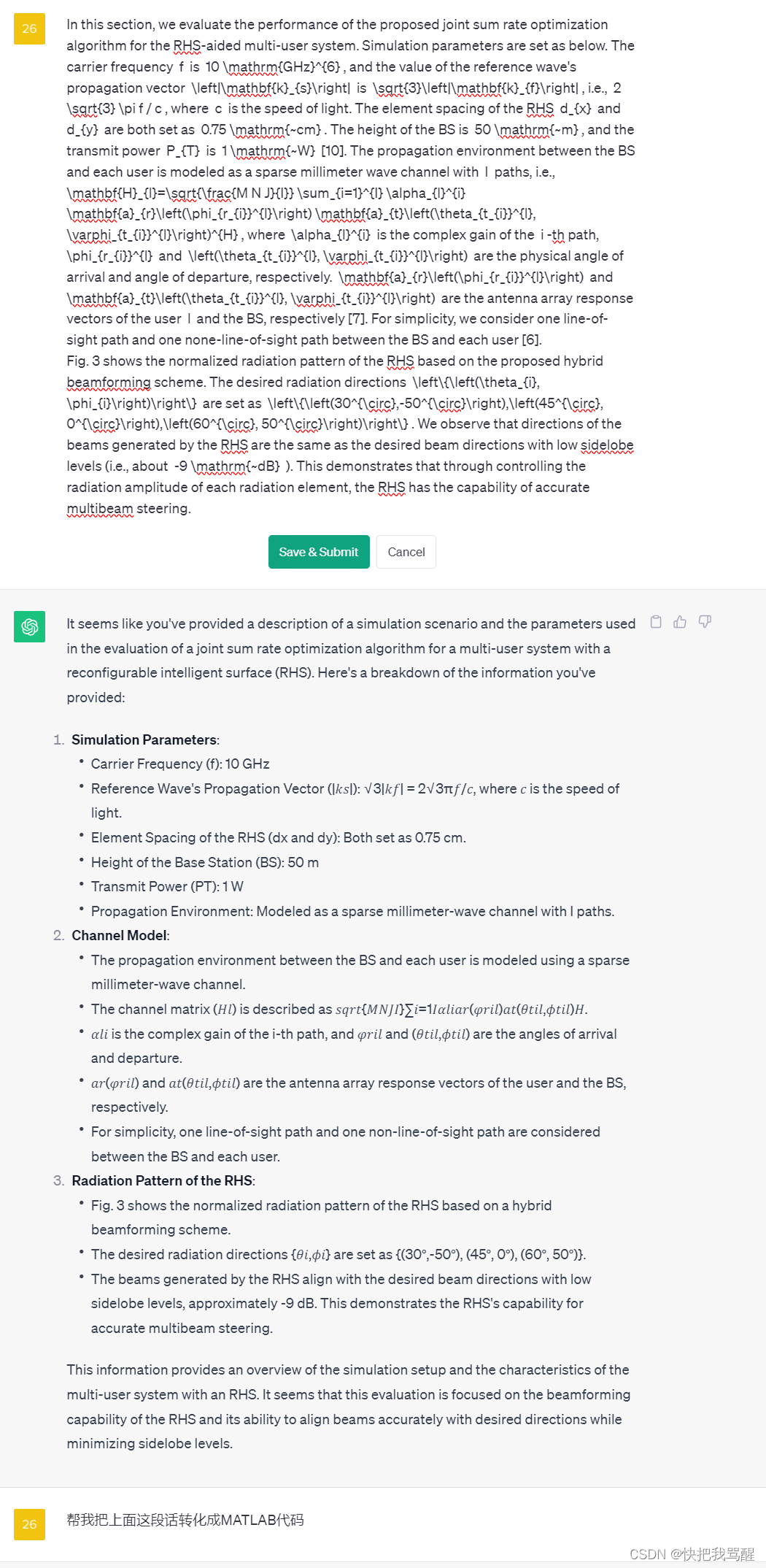
Holographic MIMO Surfaces (HMIMOS)以及Reconfigurable Holographic Surface(RHS)仿真
这里写目录标题 Simulation setupchatgpt帮我总结代码总结:chatgpt生成的代码还是不靠谱:考虑把之前看的RHS中对于多用户的改成单用户全系MIMO与普通MIMO或者说RIS的区别到底是啥? Holographic MIMO Surfaces (HMIMOS)…...

RK3568笔记一:RKNN开发环境搭建
若该文为原创文章,转载请注明原文出处。 由于对AI的好奇,想要学习如何部署AI,所以从RV1126到RK3568中过渡。 一、介绍 RK3568开发板使用的是正点原子新出的ATK-DLRK3568 开发板,主要是学习从训练到部署的全过程,并记…...

设计模式 - 行为型模式:策略模式(概述 | 案例实现 | 优缺点 | 使用场景)
目录 一、行为型模式 1.1、策略模式 1.1.1、概论 1.1.2、案例实现 1.1.3、优缺点 1.1.4、使用场景 一、行为型模式 1.1、策略模式 1.1.1、概论 策略模式设计的每一个算法都封装了起来,使他们可以相互替换,通过一个对象委派不同的算法给相应的客户…...
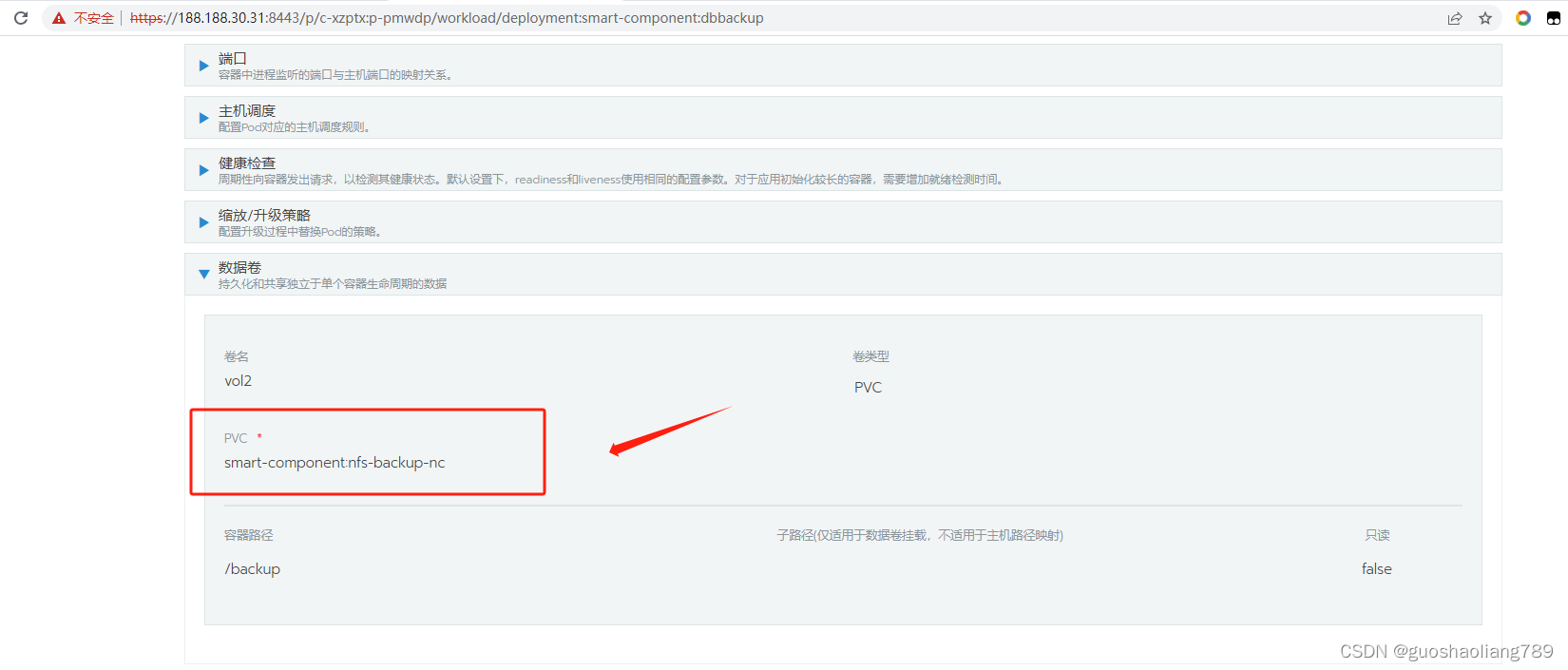
rancher部署pv、pvc、离线部署nfs
(1)NFS离线安装 使用nfs配置两台机器共享目录 假设两台机器188.188.30.32(服务端)、188.188.30.31(客户端)配置nfs 1.在可以联网的机器上下载rpm安装包 yum -y install nfs-utils --downloadonly --dow…...

视频拍摄教程分享
(1)新片场:静物美食视频拍摄(22.76GB) 链接:https://pan.baidu.com/s/1uj6wcPXGw-ztLQ1cdyogTA 提取码:929z(永久有效) (2)新片场:《孙晓迪分镜头脚本》掌握10种类型商业广告创作思…...

IP组成,分类,子网划分
一、基本概念 IP地址是指互联网协议地址,IP地址是IP协议提供的一种统一的地址格式,他为互联网上的每一个网络和每一台主机分配了一个逻辑地址,以此来屏蔽物理地址的差异,每个ip地址由网络地址和主机地址两个部分组成,网…...

Python视频剪辑-Moviepy视频内容变换技术
在视频编辑中,内容变换是个不能忽视的环节。这不仅仅是关于视频的方向、颜色或者大小,更多的是关于如何让视频内容更具创造性和吸引力。接下来将深入探讨如何使用MoviePy库进行高级的视频内容变换。 文章目录 视频内容变换函数剪辑逆时针旋转指定的角度或弧度像素的RGB值各取…...

OceanBase 数据库入门知识
🙈作者简介:练习时长两年半的Java up主 🙉个人主页:程序员老茶 🙊 ps:点赞👍是免费的,却可以让写博客的作者开兴好久好久😎 📚系列专栏:Java全栈,…...
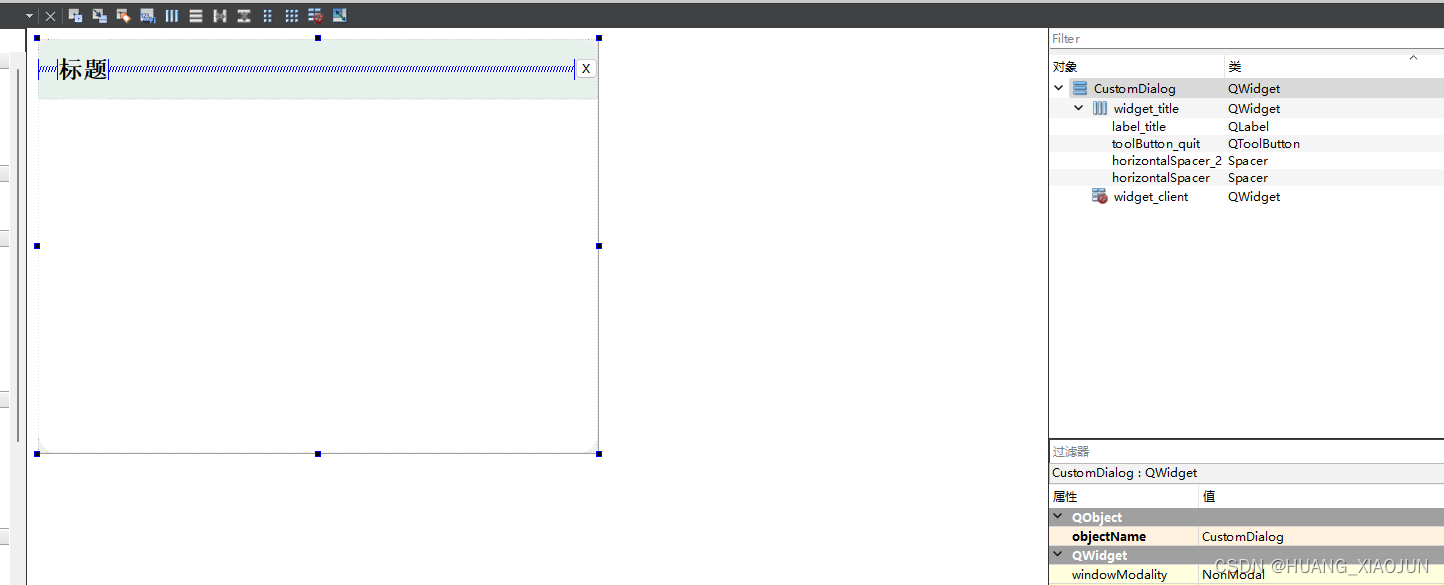
自定义无边框窗口
效果: 可拖动拉伸 ui:设计如下 样式表:在ui CustomDialog 里设置的 #widget_title{background: #E6F1EB;border-top-left-radius: 20px;border-top-right-radius: 20px;}#widget_client{background-color: rgb(255, 255, 255);border-bottom…...

【网络安全 --- kali2023安装】超详细的kali2023安装教程(提供镜像资源)
如果你还没有安装vmware 虚拟机,请参考下面博客安装 【网络安全 --- 工具安装】VMware 16.0 详细安装过程(提供资源)-CSDN博客【网络安全 --- 工具安装】VMware 16.0 详细安装过程(提供资源)https://blog.csdn.net/m0…...
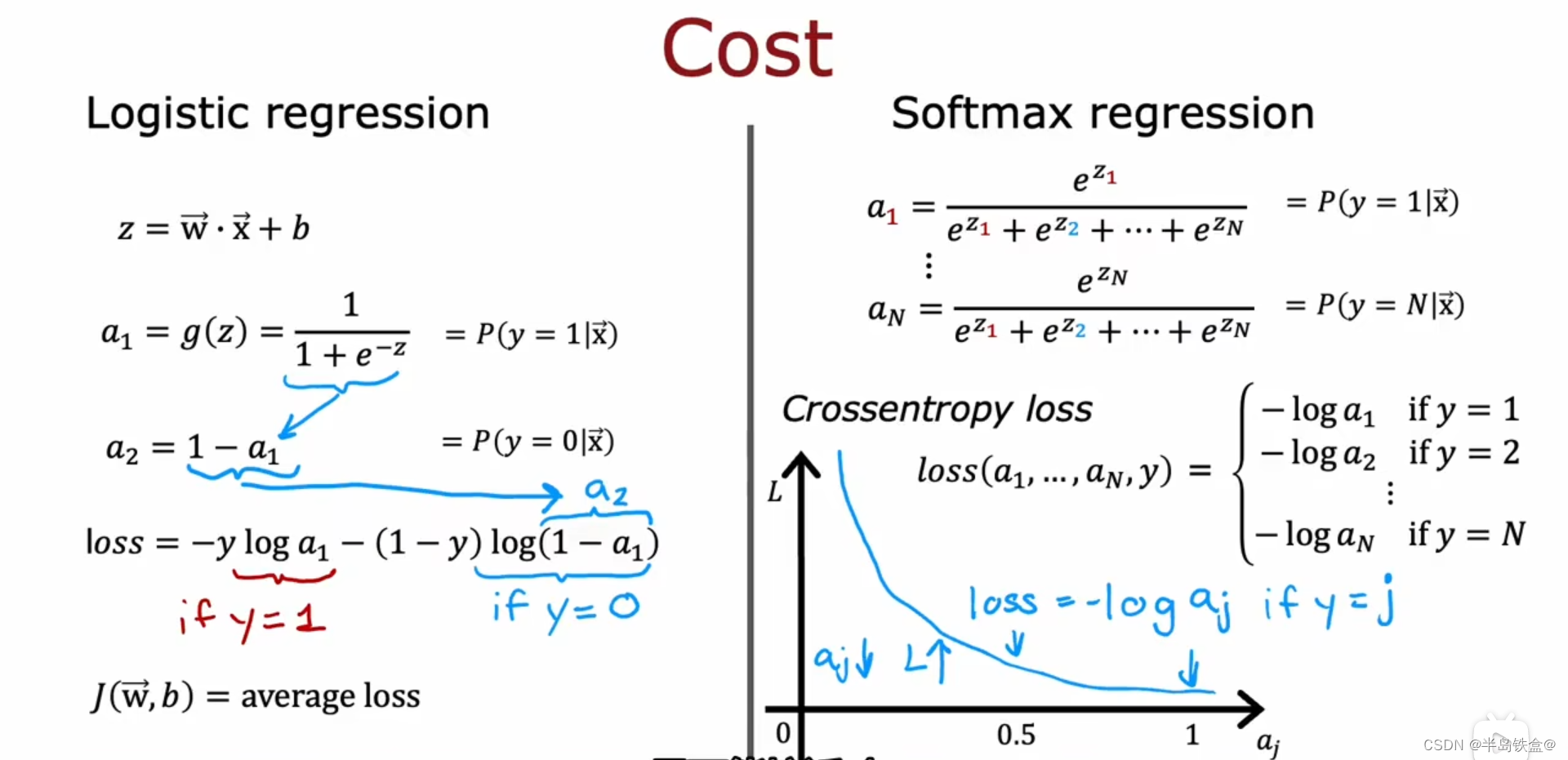
机器学习笔记(二)
过拟合 如下图左边,模型出现了过拟合现象 为了解决过拟合现象, 其中一个做法是多收集数据,如右图。 第二种做法是减少模型的特征数量,即x 第三种做法是正则化 正则化就是减少x前面的参数 w的数值, 不用消除x 正则化的梯度下降如下, 因为只是缩小了w的值,而 b的值保持不变 …...

Java @Override 注解
在代码中,你可能会看到大量的 Override 注解。 这个注解简单来说就是让编译器去读的,能够避免你在写代码的时候犯一些低级的拼写错误。 Java Override 注解用来指定方法重写(Override),只能修饰方法并且只能用于方法…...

用rabbitMq 怎么处理“延迟消息队列”?
延迟消息队列是一种允许消息在发送后等待一段时间,然后再被消费的机制。这种机制通常用于需要延迟处理的应用场景,如定时任务、消息重试、消息调度等。在 RabbitMQ 中,实现延迟消息队列需要使用一些额外的组件和技术,因为 RabbitM…...

不常见的JS加密分析
前言 今天发现一个很少见的JS加密代码,他由一段十分少见的环境检测逻辑,修改一个字符都会被检测到,十分神奇,今天献上。 源代码 let hiJsJiami;!function(){const Zg3GArray.prototype.slice.call(arguments);return eval(&…...
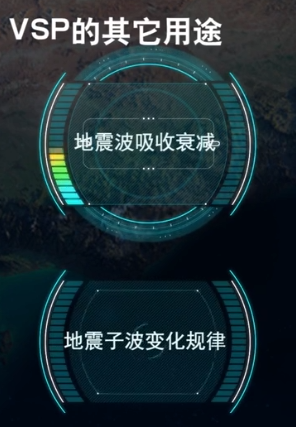
地震勘探——干扰波识别、井中地震时距曲线特点
目录 干扰波识别反射波地震勘探的干扰波 井中地震时距曲线特点 干扰波识别 有效波:可以用来解决所提出的地质任务的波;干扰波:所有妨碍辨认、追踪有效波的其他波。 地震勘探中,有效波和干扰波是相对的。例如,在反射波…...

页面渲染流程与性能优化
页面渲染流程与性能优化详解(完整版) 一、现代浏览器渲染流程(详细说明) 1. 构建DOM树 浏览器接收到HTML文档后,会逐步解析并构建DOM(Document Object Model)树。具体过程如下: (…...
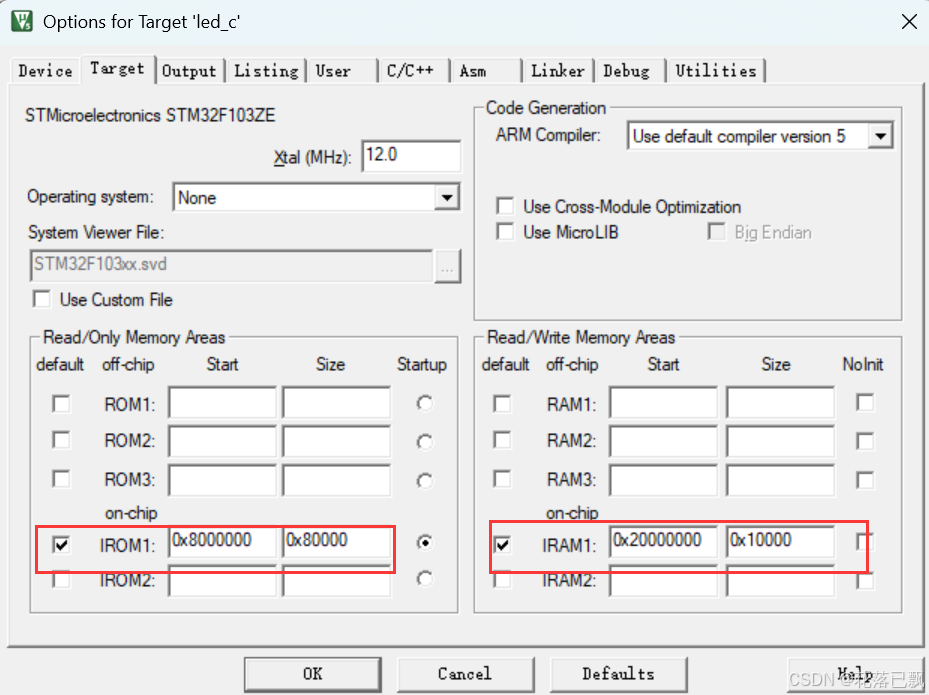
Keil 中设置 STM32 Flash 和 RAM 地址详解
文章目录 Keil 中设置 STM32 Flash 和 RAM 地址详解一、Flash 和 RAM 配置界面(Target 选项卡)1. IROM1(用于配置 Flash)2. IRAM1(用于配置 RAM)二、链接器设置界面(Linker 选项卡)1. 勾选“Use Memory Layout from Target Dialog”2. 查看链接器参数(如果没有勾选上面…...
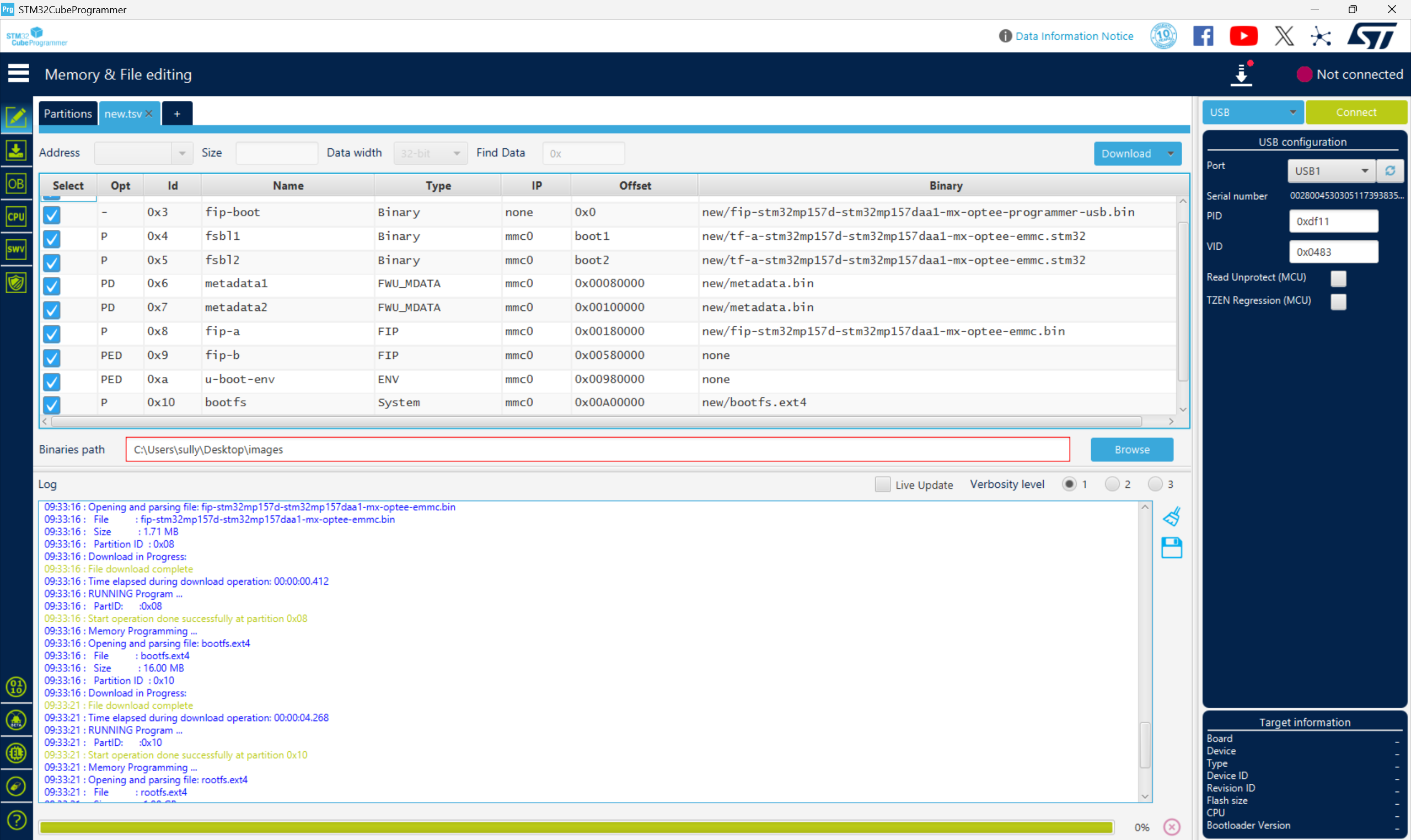
从零开始打造 OpenSTLinux 6.6 Yocto 系统(基于STM32CubeMX)(九)
设备树移植 和uboot设备树修改的内容同步到kernel将设备树stm32mp157d-stm32mp157daa1-mx.dts复制到内核源码目录下 源码修改及编译 修改arch/arm/boot/dts/st/Makefile,新增设备树编译 stm32mp157f-ev1-m4-examples.dtb \stm32mp157d-stm32mp157daa1-mx.dtb修改…...
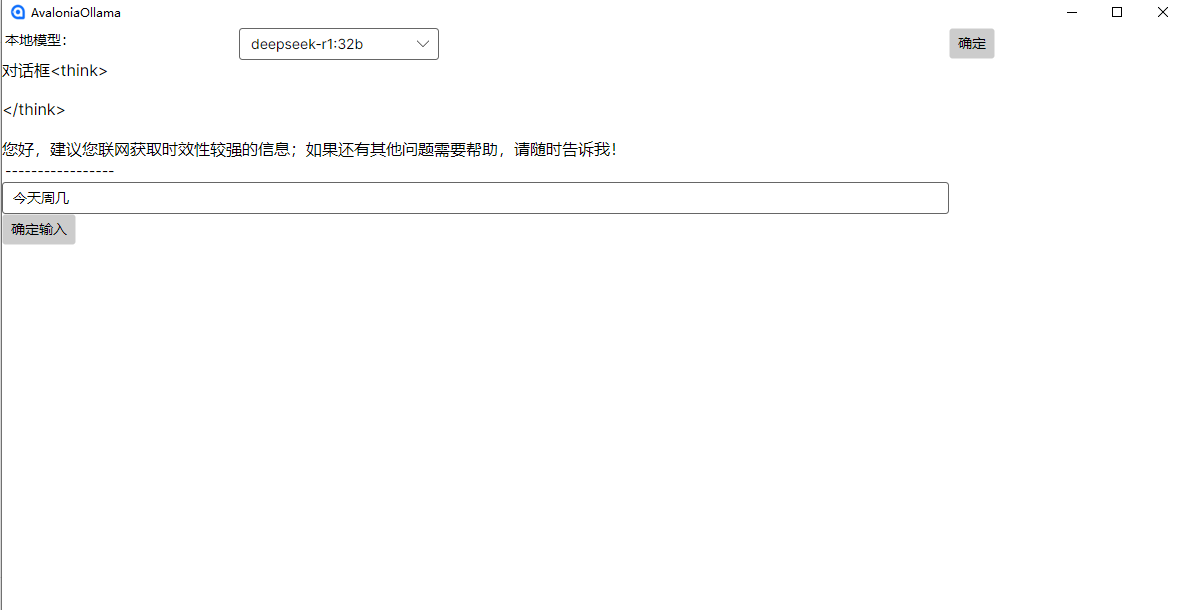
c#开发AI模型对话
AI模型 前面已经介绍了一般AI模型本地部署,直接调用现成的模型数据。这里主要讲述讲接口集成到我们自己的程序中使用方式。 微软提供了ML.NET来开发和使用AI模型,但是目前国内可能使用不多,至少实践例子很少看见。开发训练模型就不介绍了&am…...

什么是Ansible Jinja2
理解 Ansible Jinja2 模板 Ansible 是一款功能强大的开源自动化工具,可让您无缝地管理和配置系统。Ansible 的一大亮点是它使用 Jinja2 模板,允许您根据变量数据动态生成文件、配置设置和脚本。本文将向您介绍 Ansible 中的 Jinja2 模板,并通…...

稳定币的深度剖析与展望
一、引言 在当今数字化浪潮席卷全球的时代,加密货币作为一种新兴的金融现象,正以前所未有的速度改变着我们对传统货币和金融体系的认知。然而,加密货币市场的高度波动性却成为了其广泛应用和普及的一大障碍。在这样的背景下,稳定…...

Java线上CPU飙高问题排查全指南
一、引言 在Java应用的线上运行环境中,CPU飙高是一个常见且棘手的性能问题。当系统出现CPU飙高时,通常会导致应用响应缓慢,甚至服务不可用,严重影响用户体验和业务运行。因此,掌握一套科学有效的CPU飙高问题排查方法&…...
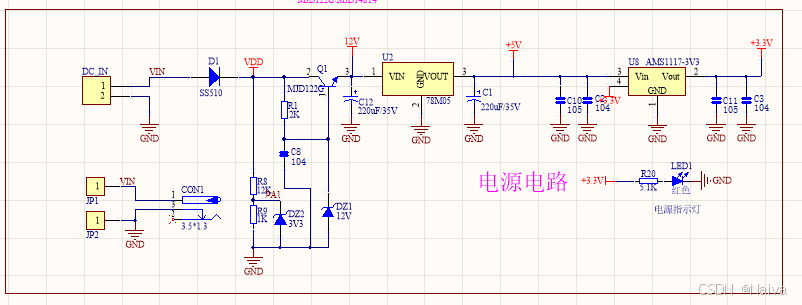
【电力电子】基于STM32F103C8T6单片机双极性SPWM逆变(硬件篇)
本项目是基于 STM32F103C8T6 微控制器的 SPWM(正弦脉宽调制)电源模块,能够生成可调频率和幅值的正弦波交流电源输出。该项目适用于逆变器、UPS电源、变频器等应用场景。 供电电源 输入电压采集 上图为本设计的电源电路,图中 D1 为二极管, 其目的是防止正负极电源反接, …...

Proxmox Mail Gateway安装指南:从零开始配置高效邮件过滤系统
💝💝💝欢迎莅临我的博客,很高兴能够在这里和您见面!希望您在这里可以感受到一份轻松愉快的氛围,不仅可以获得有趣的内容和知识,也可以畅所欲言、分享您的想法和见解。 推荐:「storms…...
